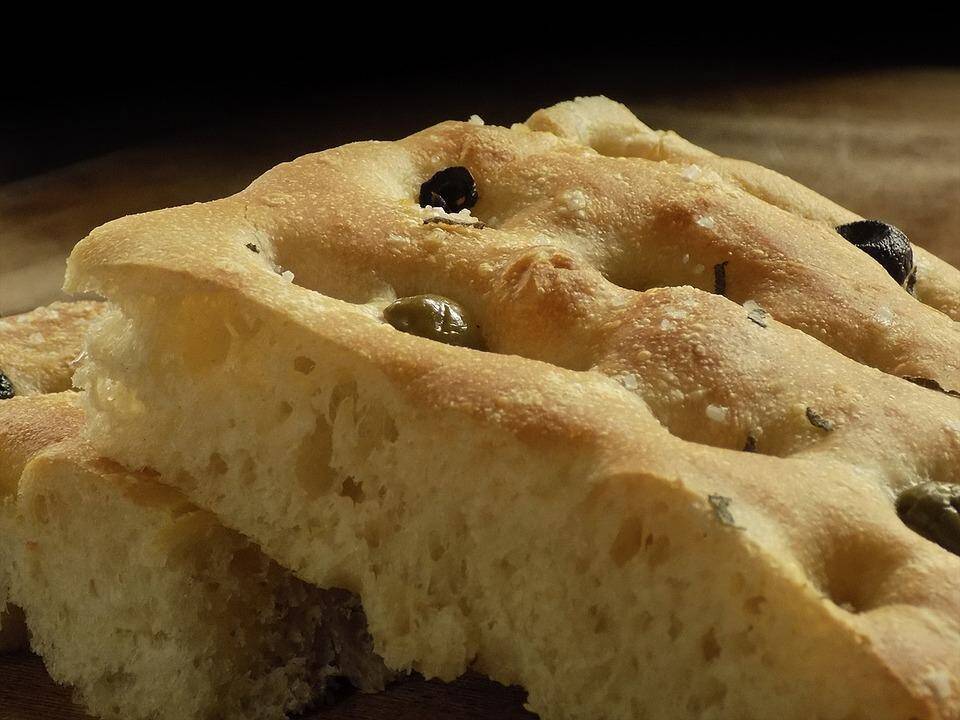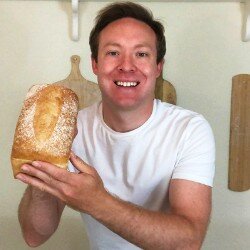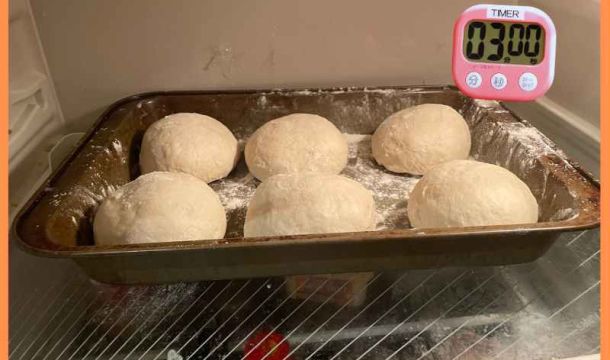
Should I Put Less Yeast In My Bread | How Much Yeast To Use?

When I first learnt to bake, the idea of putting less yeast in my bread was never considered! In reality, we would often double or triple the amount of yeast in the recipe. Partly to get the range out quicker. Partly for fun. I soon realised it wasn’t the best idea. Fortunately, I fell in love with artisan baking and learned never to do this again! So, what happens when you add too much yeast to bread? Should you put less yeast in your bread? And, what are the signs that you should cut back on the yeast? I’m going to answer all of these questions in this post.
What happens to yeast when it is added to flour?
Yeast is a type of levain, which is a product that raises bread. Different types of levain include bakers yeast, dried yeast, sourdough, poolishs’, bigas’ and bicarbonate of soda. Yeast reacts with the moistened starch (sugar) in the flour which creates carbon dioxide (gas) and ethanol. The gas gets trapped in the gluten structure and raises the bread. Most of the ethanol burns away in the oven however some still remains to add flavour.
In bread that has too much yeast, the yeast and ethanol aroma will remain in the bread after baking which can be unpleasant. If you notice this in your bread then it’s a good idea to consider reducing the amount of yeast in your recipe.
Tip: For a comprehensive guide on what yeast does in bread making, see the dough fermentation process.
How much yeast should I add to my bread
The amount of fresh yeast used in a standard bread recipe is between 1.6% and 2.2% of the total amount of flour used in the recipe. The typical starting point for a new recipe is 2%, and you’ll expect to see the majority of bread recipes use this amount.
When using activated dried or instant yeast, the percentages are lowered to compensate for their potency. Here’s a table of suggested quantities between yeast types:
| Low | Standard | High | |
| Fresh | 1.6% | 2% | 2.2% |
| Active dried | 0.70% | 0.88% | 0.97% |
| Instant | 0.53% | 0.66% | 0.73% |
For a large loaf suitable for a standard bread tin using 550 grams of flour, the amount of yeast used is typically 11 grams of fresh yeast, 5 grams of active yeast or 4 grams of instant yeast. When it comes to dried yeast, this works out the same as 1¼ teaspoon.
| Low (grams) | Standard (grams) | High (grams) | |
| Fresh | 8.80 | 11.00 | 12.10 |
| Active dried | 3.85 | 4.85 | 5.33 |
| Instant | 2.92 | 3.63 | 4.02 |
NOTE: Instant yeast and active dried yeast is often sold in 7-gram pouches. To follow the 2% rule, it should be used with 1000 or 1060 grams respectively of flour. This is enough to make 2 medium-sized loaves.
The amount of yeast used in a recipe can increase to around 3% where the dough finds it harder to rise. Examples include rye bread and those containing high quantities of fat and/or sugar. Less can also be used, circa 1.2-1.5% for longer fermentation times or when yeast is used in a preferment to pre-mature part of the flour.
It’s best to use the least amount of yeast required to levain the bread. This promotes the most gains in flavour whilst a slower fermentation time enhances the structure of the gluten.

What happens when you add too much yeast to bread?
When too much yeast is added to the dough, the activity of gas and ethanol increases rapidly to create a gassy dough that’s hard to work with! Adding too much yeast forces the dough to rise quickly. The dough structure will not be properly developed, yet, despite it rising to the expected proofing height, the gluten structure is often not developed enough. Common traits of bread where too much yeast has been added include:
- Uncontrollably large oven spring rise
- Uneven crumb structure/holes throughout the crumb
- Risk of dough collapsing when scoring or baking
- Taste is diminished through a lack of fermentation activity
- The flavour and smell of yeast are overpowering
- Dough rises too fast and is impossible to manage in a professional environment
A big oven spring is one of the most notable factors when adding too much yeast. We would often have to use a piece of cardboard to protect the top of the crust* as we tugged them out of the deck oven! Adding high quantities to bread dough (as I did in my early career) does not produce a quality product.
*this never really worked as the weak crust would shatter or crush anyway.
Bread made with too much yeast often has holes through it. This can vary from one large crater to several smaller ones. Either in one area or frustratingly through the length of the crumb, known as “tunnelling”. These holes are formed as the gluten structure has not had enough time to develop, forming an imbalance between gas production and gluten development. The structure is then not strong enough to effectively retain gas.
As the bread rises erratically in the oven, the gas expands smaller breaks in the gluten structure and creates new ones. If a bubble of gas appears close to the crust, it can expand to separate the crust from the rest of the loaf. A separated crust, or “lifted crust” is an easy tell-tell sign that there was too much yeast in the bread. And is likely to happen as the outside of the bread absorbs heat before the core, so there is more erratic behaviour in this area at the start of baking.
A small amount of yeast will be strong enough to raise a large amount of dough. It just takes longer to do so. Using less yeast slows the development time and allows the flavour of nicely fermented flour to shine through.
How to prevent adding too much yeast to bread
The best way to avoid adding too much yeast to bread is to not half a recipe in your head. Write it down so you don’t make that mistake! Another place where bakers often get stuck is not weighing the yeast using scales. Cups and spoons are great for making cakes and cooking but when it comes to making bread, the difference between a packed cup of flour to a level one can make a massive difference. Why have the stress of guessing when you can use scales and know that you have other weights correct?
Any decent set of scales that weighs in grams can be used. For most of my bread baking, I use a set of KD7000 scales from Myweigh. They are great for getting accuracy to the gram and much more user-friendly and robust when it comes to using them for dividing dough weights. To be proper geeky (like me) you might want to get yourself scales that are more accurate. Now, you could spend hundreds, if not thousands on scales, but I bought a cheap set of jewellery scales from Amazon and they are perfect! I have to keep them clean and be sure not to throw them around, but I’m now able to measure my ingredients to 0.01 of a gram.
What to do if you add too much yeast to bread
Although you are unlikely to be able to enjoy the style of loaf you intended, there are a few tricks you can use to rescue an over-yeasted dough. Here are the best ways how to fix too much yeast in bread:
- Midway through mixing, place the dough in the fridge to cool for ten minutes before mixing again
- Prepare for a big oven spring by under proofing the bread slightly
- Increase the salt to 2.2% of the flour used in the recipe. Salt helps to control the yeast.
- Lower the temperature of the dough
- Don’t cut the bread before baking if it has had a quick rise
- Place in the fridge and use as a pâte fermentée in the following day’s dough
How to control the rise of bread
If you are wanting to slow down the rise of bread dough during its first or second rise, primarily, you can do two things:
- Use less yeast
- Lower the temperature of the dough
You can also opt to do a bit of both. Yeast operates quickest when it is warm therefore cooling the dough leads to less yeast activity. The yeast will remain in the bread so, no matter what, if you put too much yeast in bread it can still taste yeasty. The reason why you might want to cool the dough if this happens is to allow the naturally occurring gluten maturity to catch up. Depending on the amount of yeast you have added, you’ll want to be more extravagant when lowering of the temperature.
What happens if you put less yeast in bread?
What happens when you add less yeast? Putting less yeast in a bread recipe slows the development of the dough. Slowly fermented bread made with less yeast makes a better loaf of bread with more flavour and aromatics. It also makes a stronger gluten network which gives the bread a better crust and crumb.
Textural benefits include:
- Crispier crust
- Soft crumb
- Enhanced gas retention properties
- Uniform crumb structure
See the bulk fermentation article to expand on the long vs short fermentation duration argument.
One of the golden rules in artisan baking is to give the dough time to develop. This creates sweet flavoursome bread. The sweetness is provided by starches who, when awarded enough time, break down into sugars.
Using a poolish preferment instead of a long rise
You may choose to create a preferment called a poolish to your bread dough. A poolish is an equal amount of water to flour with a tiny amount of yeast. It’s then lightly mixed for around a minute before being left to develop for 12-18 hours, or longer if put in the fridge. It’s a Polish method that was accepted by French bakers years ago and is now a common technique used across the world.
During the development time, the yeast multiplies whilst the water and the flour combine to create a strong gluten structure. The poolish is then added to the bread dough and no more -sometimes a tiny bit of yeast is added. This technique reduces the amount of yeast needed and creates a strong crumb structure. This process is common in artisan baking.
When making baguettes or bread with large holes in it, it is essential. A biga is from the Italians and works in much the same way. The flour-to-water ratio can be adapted. A strong biga is perfect for ciabatta and focaccia.
What happens if you put too little yeast in bread?
If you realise that you have not added enough yeast, the bread will rise very slowly and have a high risk of drying out. If the dough was well kneaded, there is a chance that the gluten may become too strong and eventually, the dough collapses.
What do you do if there is not enough yeast in the dough?
It is possible to add more yeast to the dough whilst it is being kneaded, and even during its first rise. Doing this is a lot easier when the yeast has been dissolved in water before its inclusion. This helps the mixture to be evenly distributed throughout the dough.
The other option, and the only option if you realise this once the dough has been shaped and in its proofing basket or bread tin is to warm it up and wait. Try to proof the dough at around 38C (100F) so the yeast is more active and wait for it to rise. Keep the dough covered at all times and rub a little water on the surface if you see the dough drying out. See why isn’t my bread rising to learn more techniques to counteract a slow-rising dough.
Should I add more yeast to bread, ever?
Sometimes a high ratio of yeast to flour can be helpful if you want your bread to have less flavour. Typically a sandwich bread is designed to be lighter as the flavour of the filling is the celebration. By decreasing the development time, the bread will have a weakened structure. To counteract this the baker may need to add more salt or bread improvers to the recipe. Salt strengthens the gluten strands and slows down the action of the yeast. This, like certain bread improvers, aid the dough in holding shape.
Tips for selecting yeast
I recommend you choose a particular yeast and stick to it. You don’t need to use fresh yeast, but if you would prefer to, you can often buy it from a local bakery. Just ask at any bakery counter for some fresh yeast. Most will sell some to you.
Ending thoughts on using less yeast in bread
So before artisan became a “thing”, we bakers were passionate about the volume of bread we could knock out and not a lot else. Quality wasn’t important. Well, not in the company I kept anyway. It’s not that way anymore. There’s a new culture now. Bread quality is the premium focus. Some of my favourite bakes take 2-4 days to develop into the perfect loaf. A long development time creates an intense density of texture and flavour in the bread.
Frequently asked questions about yeast in bread
If you’ve enjoyed this article and wish to treat me to a coffee, you can by following the link below – Thanks x

Hi, I’m Gareth Busby, a baking coach, head baker and bread-baking fanatic! My aim is to use science, techniques and 15 years of baking experience to help you become a better baker.
Table of Contents
- What happens to yeast when it is added to flour?
- How much yeast should I add to my bread
- What happens when you add too much yeast to bread?
- How to prevent adding too much yeast to bread
- What to do if you add too much yeast to bread
- How to control the rise of bread
- What happens if you put less yeast in bread?
- What happens if you put too little yeast in bread?
- What do you do if there is not enough yeast in the dough?
- Should I add more yeast to bread, ever?
- Tips for selecting yeast
- Ending thoughts on using less yeast in bread
- Frequently asked questions about yeast in bread
Related Recipes
Related Articles
Keep up to date with the latest Articles, Recipes & Bread Baking info by joining my mailing list
Join The Weekly Bread Baker's Newsletter!
Latest Articles
Baking Categories
Disclaimer
Address
8 Woodland Avenue,
Worthing
West Sussex
BN13 3AF
UK







